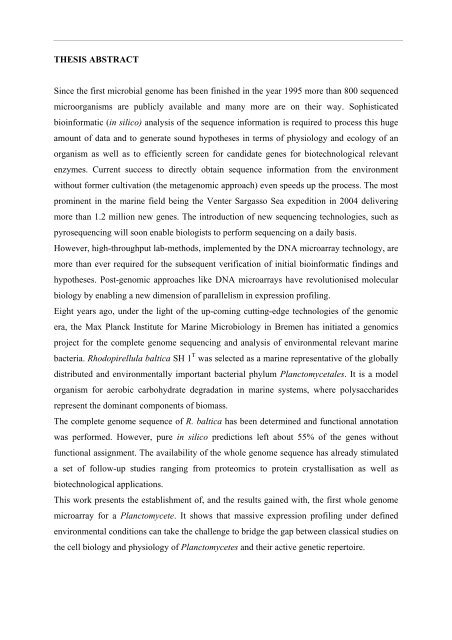a Whole Genome Array Approach - Jacobs University
a Whole Genome Array Approach - Jacobs University
a Whole Genome Array Approach - Jacobs University
Create successful ePaper yourself
Turn your PDF publications into a flip-book with our unique Google optimized e-Paper software.
THESIS ABSTRACT<br />
Since the first microbial genome has been finished in the year 1995 more than 800 sequenced<br />
microorganisms are publicly available and many more are on their way. Sophisticated<br />
bioinformatic (in silico) analysis of the sequence information is required to process this huge<br />
amount of data and to generate sound hypotheses in terms of physiology and ecology of an<br />
organism as well as to efficiently screen for candidate genes for biotechnological relevant<br />
enzymes. Current success to directly obtain sequence information from the environment<br />
without former cultivation (the metagenomic approach) even speeds up the process. The most<br />
prominent in the marine field being the Venter Sargasso Sea expedition in 2004 delivering<br />
more than 1.2 million new genes. The introduction of new sequencing technologies, such as<br />
pyrosequencing will soon enable biologists to perform sequencing on a daily basis.<br />
However, high-throughput lab-methods, implemented by the DNA microarray technology, are<br />
more than ever required for the subsequent verification of initial bioinformatic findings and<br />
hypotheses. Post-genomic approaches like DNA microarrays have revolutionised molecular<br />
biology by enabling a new dimension of parallelism in expression profiling.<br />
Eight years ago, under the light of the up-coming cutting-edge technologies of the genomic<br />
era, the Max Planck Institute for Marine Microbiology in Bremen has initiated a genomics<br />
project for the complete genome sequencing and analysis of environmental relevant marine<br />
bacteria. Rhodopirellula baltica SH 1 T was selected as a marine representative of the globally<br />
distributed and environmentally important bacterial phylum Planctomycetales. It is a model<br />
organism for aerobic carbohydrate degradation in marine systems, where polysaccharides<br />
represent the dominant components of biomass.<br />
The complete genome sequence of R. baltica has been determined and functional annotation<br />
was performed. However, pure in silico predictions left about 55% of the genes without<br />
functional assignment. The availability of the whole genome sequence has already stimulated<br />
a set of follow-up studies ranging from proteomics to protein crystallisation as well as<br />
biotechnological applications.<br />
This work presents the establishment of, and the results gained with, the first whole genome<br />
microarray for a Planctomycete. It shows that massive expression profiling under defined<br />
environmental conditions can take the challenge to bridge the gap between classical studies on<br />
the cell biology and physiology of Planctomycetes and their active genetic repertoire.<br />
4

















